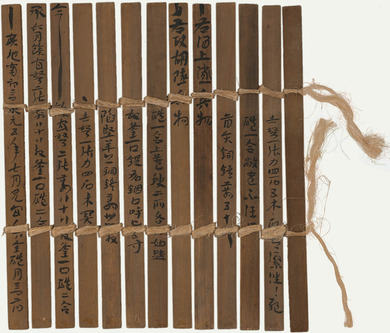Chinese book made of bamboo
Chinese book made of bamboo
The handwritten weapons directory stands out because of its form, which is unusual in our writing culture. It consists of 13 narrow bamboo sticks with letters written on them and tied together with two pieces of string. The original comes from Northern China from the Han Dynasty (206 BCE to 200 CE). Besides military and ceremonial documents, contracts and laws, important texts about medicine, the art of war, history and philosophical classics from Taoism or Confucianism like the I Ging (Book of Transformations) or the Li Ji (Book of Rites), were recorded on bamboo tablets like this.
Long before the invention of paper, other materials like stone, bronze, bone or seashells were used in China to record information in writing. Historical texts imply that wooden and bamboo tablets were already used as writing materials in the 21st century BCE. These were bound using hemp or silk thread to make long rolled or foldable tablets and this is how, in around the 6th century BCE, the first book form emerged. Producing these plant-based carriers of the written word, also called “Jian Ce” or “Jian Du”, involved a lot of work. The bamboo had to be dried, the bark removed, cut into small tablets and dried over fire to make them durable. The length and number of the tablets varied depending on the importance of the text. The writing was done using a brush and water-insoluble ink or India/China ink. The elongated form and arrangement of the tablets was determined by the writing direction, which was in columns from top to bottom and from right to left. This influenced the form of Chinese writing over a period of centuries right up to the writing reform in 1956.

